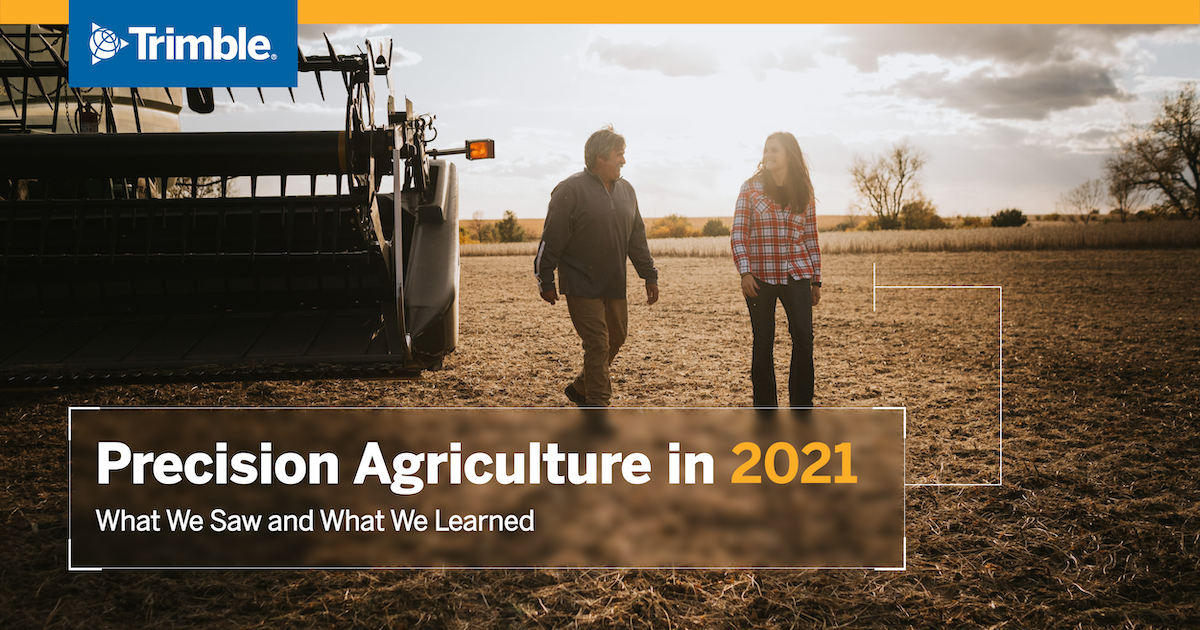2021 Wrap-Up: Top Precision Ag Trends of the Year
December 20, 2021

With 2022 right around the corner, it’s a time to reflect on all of the changes that happened in agriculture over the past 12 months. Leading into this year, farmers continued in unpredictable territory as the global pandemic continued and supply chain challenges disrupted industries across the globe.
Despite these obstacles, precision agriculture technology helped farmers push forward with exciting new innovations and ever-improved technology. Let’s take a look at the top 10 precision agriculture trends of 2021.
-
Continued Use of Drones
The use of drones in agriculture has been increasing throughout the last decade, and it doesn’t show signs of slowing down anytime soon. According to Market Study Report, the global agricultural drone market will increase by 35.9% between 2021 and 2027 as new companies enter the market and more farmers take advantage of drone technology. In 2021, farmers used drones to support field mapping, variable rate application (VRA), crop scouting, and more.
-
A Transition Towards Electric Equipment
As electric vehicle sales increased an average of 50% between 2015-2021, the agriculture sector worked to transition diesel-powered farm equipment to electric options. Monarch, an electric tractor company backed by Trimble Ventures, is a leader in the industry with its MK-V tractor. This driver-optional tractor is powered by a battery with a 10+ hour runtime and features a built-in smart screen. Along with these advanced features, it also comes with a hydraulic top and side arms so farmers can easily hook up to their existing implements.
-
Demand for Product Traceability
Blockchain technology is being used to allow consumers to track their food from seed to plate. As consumers became more interested in where their food came from and governments continue to aim to pinpoint the sources of food-borne illnesses, 2021 showed an increase in the demand for product traceability.
-
Digital Information Sharing
While we all wish COVID-19 ended in 2020, the virus continued to impact both global markets and small communities in 2021. Not only did the pandemic require a switch to digital communication, but 2021 also showed that many people valued the time-saving advantages of digital information sharing and remote support. Precision agriculture software such as Farmer Core made it easy to obtain precise data to share with employees and ag professionals like crop advisors or agronomists.
-
Accurate Yield Monitoring
Learning what varieties of inputs perform best on your operation is essential to maximize materials and offset rising costs. Yield monitoring continued to be a popular topic in 2021 as farmers leaned on this technology to obtain accurate volume and moisture content data. Having defined data allows farmers to zero in on the precise amounts of materials required, so you spend only where needed.
-
Enhanced Focus on ROI
As the pandemic disrupted global supply chains, farmers sometimes found it difficult to obtain inputs and labor. When they could find fertilizer, seeds, and other necessary materials, they, unfortunately, paid more than in the past. To maintain a good ROI, farmers explored ways to decrease their input costs, such as relying on precision agriculture to apply inputs. Products like Trimble’s Field-IQ™ System allowed farmers to apply just the amount of inputs plants needed, no more and no less, ultimately leading to a greater ROI.
-
Autonomous Equipment
Farmers continued to automate their operations with soil sensors, satellite imaging, autonomous tractors, and more. This equipment was especially important in 2021, as many operations dealt with labor shortages. One promising story in agricultural automation is Trimble Agriculture’s recent partnership with HORSCH. Leaders believe this partnership will allow for continued advancements in automation – and it’s already getting started.
-
Carbon Credits
As governments, organizations, and consumers increased conversations around carbon sequestration, the market for carbon credits grew. More farmers began implementing practices, such as conservation tillage and the use of cover crops, that allowed them to receive these credits. Additionally, 2021 saw the expansion of carbon monitoring and verification software companies like Regrow. Regrow’s independent measurement, reporting and verification system (MRV) may be used to help grow carbon markets.
-
Real-Time Weather Monitoring
While all segments of the global smart agriculture market will increase between 2021 and 2026, weather monitoring and forecasting is predicted to show the largest jump. This rang true in 2021 as farmers utilized in-field sensors to receive real-time weather data to impact their decision-making.
-
Global Navigation Satellite Systems
GNSS continued to be essential for applications such as field mapping, automated steering, and soil monitoring, and livestock tracking. In 2021, this technology became faster and more accurate, with advancements like improvements to the Trimble CenterPoint® RTX correction service. With these improvements, farmers can obtain 2.5 centimeter accuracy in five minutes rather than the previous 20 minutes.
If 2021 was any indication, precision ag technology will continue to thrive and support farmers with new technologies and constant improvements to serve farms all over the world. To learn more about how to incorporate precision farming in your operation in 2022, connect with your local Trimble reseller today.
